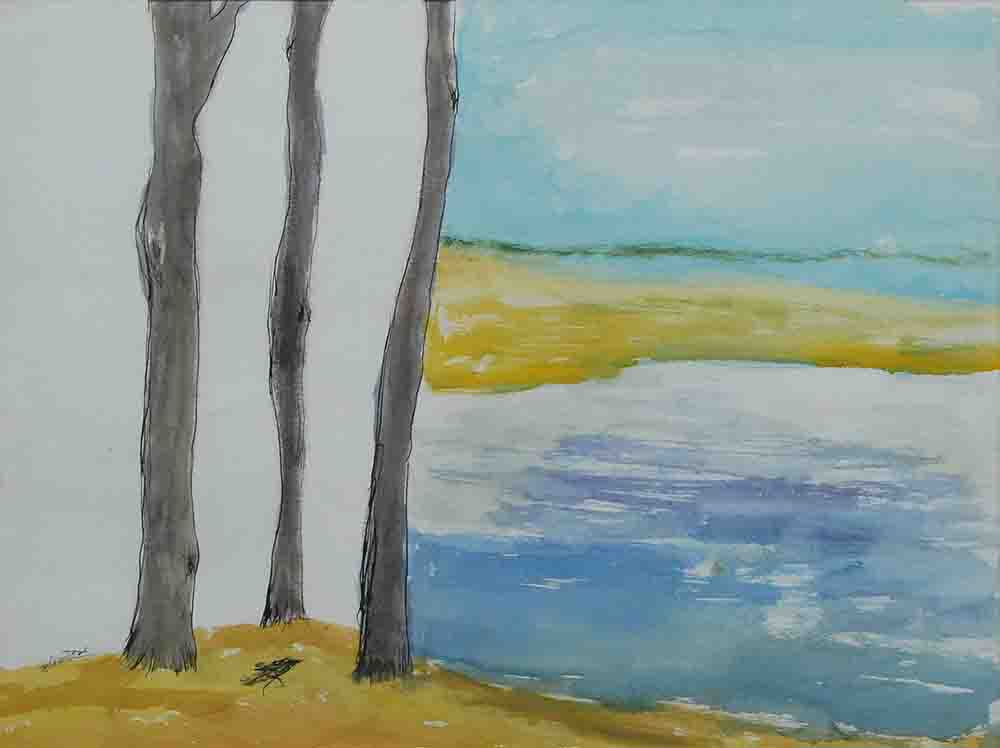Style of the Artist : After graduating from the Government College of Art and Crafts, Calcutta in 1955 Pyne began to move away from the tenets of both classical Indian and Western art to respond to the beckoning of his own artistic impulses. Landscapes fascinated him initially. But along with the world of nature and flora emerged his own reconstructed images of fauna that often signified as metaphors of human passion and energy, and his paean to the elemental magic of women. This transition may have risen from his penchant for human psychology and observing the intricacies of human behavior.
An inveterate introvert, the world of workaday reality does not attract Pyne as much as lower depths of psyche and the transformed world out of his fancy. Adherents of Surrealism thought that the horrors of World War I were the culmination of the Industrial Revolution and the result of the rational mind. Consequently, however, irrational thought and dream-states were viewed as the natural antidote to those social problems. The Surrealist diagnosis of the ‘problem’ of the realism and capitalist civilisation is a restrictive overlay of false rationality, including social and academic convention, on the free functioning of the instinctual urges of the human mind. The Surrealist ethos also connected itself with the theories of Sigmund Freud who asserted that unconscious thoughts do motivate human behaviour while advocating free association and dream analysis to reveal subterranean thoughts. In the case of Pyne too, his artistic vision does not adhere to logic because he does not see with his eyes but rather through his subconscious mind — in an act of surrender to the liberty of his dreamy vision — with little control over the wanton caprice of his depictions. So, in this distinctive vein, he is perhaps the most seminal surrealist of the contemporary Indian art.
About the Artist and his work :
Born : 1937 in Calcutta, West Bengal.
Education : 1955 Diploma in Fine Arts, Govt. College of Art and Craft, Calcutta.
Exhibitions :
1961 : AIFACS, New Delhi.
1967, 80, 82 : Academy of Fine Arts, Calcutta.
1968-87 : Lalit Kala Akademi, New Delhi.
1968 : Jehangir Art exhibition, Bombay.
1979 : 100 Years of Modern Indian Art, Fukuoka Art Museum, Japan.
1988 : Chandigarh and Chitrakoot Art exhibition, Calcutta.
1991 : Calcutta 300 – Birla Academy of Art and Culture, Calcutta.
1991, 92, 93, 95, 97, 2001 : Chitrakoot Art , Calcutta.
1992 : Gandhara Art exhibition, Calcutta and Indian Council of Cultural Relations, Bangladesh.
1993 : Bajaj Art exhib, Bombay and Asian Art Exhibition Chitrakoot Art show, Singapore.
1994 : 8th Triennial India, Lalit Kala Akademi, New Delhi.
2003 : Manifestations, organised by Delhi Art Gallery, World Trade Center, Mumbai and Delhi Art , New Delhi.
2007 : Modern to contemporary inaugural Gallerykolkata, kolkata.
Awards :
1966, 69, 73, 76 : Academy of Fine Arts Award, Calcutta.
1968-69 : Scholarship from Academy of Fine Arts, Calcutta.
1980-86 : Scholarship from Indian Cultural Trust, Calcutta.










